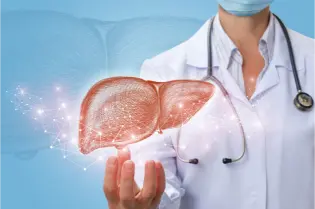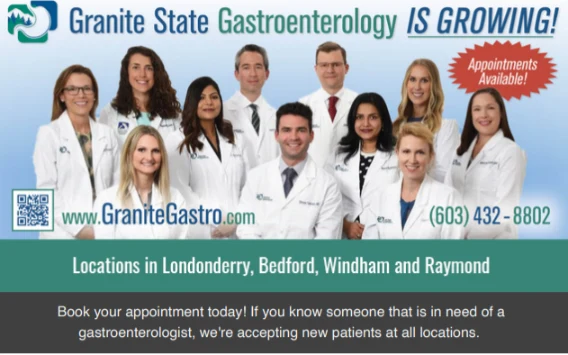Happy New Year from Granite State Gastro - Your Digestive Health Partner
As we bid farewell to the old year and embrace the new one, we wanted to take a moment to extend our warmest wishes for a Happy New Year to you and your loved ones!
At Granite State Gastroenterology, we are committed to your digestive health and we look forward to continuing our partnership with you in 2024. Your well-being is always our top priority!
Our newsletter this month has a great recipe that promotes digestive health as well as details on management of Hepatitis C in 2024, the difference between gluten intolerance and celiac disease, and the role diet plays in managing IBS.
Lots more to come in this exciting new year! Watch for our monthly newsletters and don’t forget to book your next appointment!
Warm Winter Harvest Salad

This Warm Winter Harvest Salad is a health-conscious creation that takes full advantage of the season’s offerings. It’s a fiber-rich delight that combines the earthy goodness of roasted sweet potatoes and beets with the vibrant freshness of kale and red cabbage. Topped with pomegranate seeds, toasted walnuts, and an inviting maple-mustard dressing, this salad is a flavorful and nutritious choice that supports digestive health and overall well-being. Don’t miss the chance to savor the benefits of these seasonal ingredients in one delicious bowl!
Ingredients:
For the Salad:
- 2 cups of kale, washed and chopped
- 1 cup of red cabbage, thinly sliced
- 1 cup of roasted sweet potatoes, cubed
- 1 cup of roasted beets, diced
- 1/2 cup of pomegranate seeds
- 1/4 cup of toasted walnuts, chopped
- 1/4 cup of crumbled feta cheese (optional for added flavor)
For the Maple-Mustard Dressing:
- 3 tablespoons of olive oil
- 1 tablespoon of apple cider vinegar
- 1 tablespoon of pure maple syrup
- 1 teaspoon of Dijon mustard
- Salt and black pepper to taste
Instructions:
1. Preheat your oven to 400°F (200°C).
2. Toss the sweet potato cubes and diced beets separately in olive oil, salt, and pepper. Place them on separate baking sheets in a single layer.
3. Roast the sweet potatoes for about 25-30 minutes, or until they are tender and slightly crispy, stirring occasionally. Roast the beets for about 35-40 minutes or until they are tender. Remove them from the oven and let them cool slightly.
4. While the vegetables are roasting, prepare the dressing. In a small bowl, whisk together the olive oil, apple cider vinegar, maple syrup, Dijon mustard, salt, and black pepper. Adjust the sweetness and tanginess to your liking.
5. In a large salad bowl, combine the chopped kale and thinly sliced red cabbage.
6. Add the roasted sweet potatoes, diced beets, pomegranate seeds, and toasted walnuts to the bowl.
7. If desired, sprinkle crumbled feta cheese over the top for added creaminess and flavor.
8. Drizzle the maple-mustard dressing over the salad and toss everything together until well coated.
Serve the Warm Winter Harvest Salad immediately, savoring the mix of textures, flavors, and vibrant colors. It’s a unique and delicious way to enjoy the goodness of winter vegetables while supporting your digestive health.
Hepatitis C Treatment in 2024: A Brighter Outlook

In 2024, the landscape of hepatitis C (HCV) treatment has seen remarkable advancements, offering new hope to millions of people worldwide. Hepatitis C, a viral infection affecting the liver, has traditionally been a challenging condition to manage. However, recent developments have transformed the way we approach and treat HCV.
Direct-Acting Antivirals (DAAs): Game Changers
The introduction of Direct-Acting Antivirals (DAAs) revolutionized HCV treatment. These medications specifically target the hepatitis C virus, blocking its ability to replicate and spread within the body. DAAs have virtually replaced older, less effective treatments, making the eradication of HCV more achievable than ever before.
Shorter Treatment Duration
In 2024, treatment courses for HCV have become even more patient-friendly. Many individuals now undergo shorter treatment durations, often as brief as 8-12 weeks. This is a significant improvement compared to older regimens that required months of therapy.
High Cure Rates
One of the most exciting aspects of HCV treatment in 2024 is the consistently high cure rates. DAAs have proven to be incredibly effective. This means that many patients who receive treatment successfully clear the virus from their bodies.
Fewer Side Effects
Older HCV treatments were notorious for their side effects, which could be severe and difficult to tolerate. With the advent of DAAs, the side effect profile has significantly improved. Most patients experience minimal side effects, making treatment much more comfortable.
Oral Medications
DAAs are typically administered as oral medications, eliminating the need for injections or interferon-based therapies that were common in the past. This makes treatment more convenient and accessible for patients.
Tailored Treatment Plans
In 2024, healthcare providers can tailor HCV treatment plans to each patient’s unique needs. Factors such as the specific HCV genotype and the presence of liver cirrhosis are considered when determining the most appropriate medication regimen.
Prevention and Education
While the focus of HCV treatment has shifted towards curing existing infections, prevention and education remain crucial. Efforts to raise awareness about HCV transmission, risk factors, and the availability of treatments continue to play a vital role in reducing the prevalence of the virus.
The Path Forward
The progress in HCV treatment in 2024 is truly remarkable. With highly effective and welltolerated medications, shorter treatment durations, and personalized care, the outlook for individuals living with hepatitis C has never been more optimistic. The goal of eliminating HCV as a public health concern is becoming increasingly attainable, and with ongoing research and awareness efforts, we are moving closer to a world where hepatitis C is a thing of the past.
Gluten Intolerance vs. Celiac Disease: What's the Difference?

Gluten intolerance and celiac disease are two terms often used interchangeably, but they represent distinct conditions with varying implications for your health. In this brief guide, we’ll explore the key differences between these two conditions, shedding light on what sets them apart.
Gluten Intolerance:
1. Non-Celiac Gluten Sensitivity: Gluten intolerance, often referred to as non-celiac gluten sensitivity (NCGS), is a condition in which individuals experience gastrointestinal symptoms after consuming gluten-containing foods. These symptoms can include bloating, abdominal discomfort, diarrhea, and fatigue.
2. No Autoimmune Response: Unlike celiac disease, NCGS does not involve an autoimmune response or the production of antibodies. It is not associated with the same type of intestinal damage seen in celiac disease.
3. Diagnosis Challenges: Diagnosing NCGS can be challenging because there are no specific blood tests or biomarkers for this condition. Diagnosis is often based on the exclusion of other gastrointestinal disorders, such as celiac disease and wheat allergy.
4. Symptom Management: Individuals with NCGS typically manage their symptoms by avoiding gluten-containing foods. Many find relief from their digestive discomfort by adhering to a gluten-free diet.
Celiac Disease:
1. Autoimmune Condition: Celiac disease is an autoimmune disorder triggered by the ingestion of gluten. When individuals with celiac disease consume gluten, their immune system mounts an attack on the lining of the small intestine, leading to inflammation and damage.
2. Specific Diagnostic Markers: Celiac disease can be diagnosed through blood tests that measure specific antibodies, such as anti-tissue transglutaminase (tTG) and antiendomysial antibodies (EMA). Confirmatory diagnosis often involves an intestinal biopsy.
3. Serious Health Implications: Left untreated, celiac disease can have serious health consequences, including nutrient deficiencies, osteoporosis, and an increased risk of certain cancers. It is essential for individuals with celiac disease to strictly adhere to a gluten-free diet to prevent complications.
4. Lifelong Gluten Avoidance: Unlike gluten intolerance, where symptom management through gluten avoidance is the primary treatment, individuals with celiac disease must commit to a lifelong gluten-free diet to prevent further damage to their intestines and associated health issues.
While both gluten intolerance (NCGS) and celiac disease involve sensitivity to gluten, they differ in terms of their underlying mechanisms, diagnosis, and health implications. Gluten intolerance primarily involves gastrointestinal symptoms without an autoimmune response, while celiac disease is an autoimmune condition with specific diagnostic markers and potential for serious health complications. If you suspect you may have either condition, it’s crucial to consult with a healthcare professional for proper evaluation and guidance on managing your dietary needs. Understanding these differences can help individuals make informed decisions about their health and well-being.
Dietary Strategies for Managing IBS: Finding Relief through Smart Food Choices

Diet plays a crucial role in managing Irritable Bowel Syndrome (IBS). IBS is a gastrointestinal disorder characterized by symptoms like abdominal pain, bloating, gas, and changes in bowel habits (diarrhea, constipation, or both) without any underlying structural damage. While the exact cause of IBS is not fully understood, dietary choices can significantly impact symptom severity and overall quality of life for individuals with this condition. Here’s how diet plays a role in managing IBS:
1. Identifying Trigger Foods: IBS symptoms often vary from person to person, and certain foods can trigger or worsen symptoms. Through a process of trial and error, individuals with IBS can identify specific trigger foods that exacerbate their symptoms. Common triggers include high-fat foods, dairy products, glutencontaining grains, spicy foods, caffeine, carbonated beverages, and artificial sweeteners.
2. Low FODMAP Diet: The Low FODMAP diet is a widely recognized dietary approach for managing IBS. FODMAPs (Fermentable Oligosaccharides, Disaccharides, Monosaccharides, and Polyols) are a group of poorly absorbed carbohydrates that can ferment in the gut, leading to gas, bloating, and other symptoms in individuals with IBS. The Low FODMAP diet involves temporarily reducing or eliminating highFODMAP foods from the diet and then gradually reintroducing them to identify which ones trigger symptoms.
3. Soluble Fiber: Soluble fiber can help regulate bowel movements and ease symptoms of IBS, particularly constipation. Foods rich in soluble fiber include oats, barley, bananas, and certain vegetables. Incorporating these foods into the diet can promote regularity and reduce abdominal discomfort.
4. Probiotics: Probiotics are beneficial bacteria that can help balance the gut microbiome. Some individuals with IBS may find relief from their symptoms by taking specific strains of probiotics. However, the effectiveness of probiotics can vary from person to person, so it’s essential to consult with a healthcare provider before starting any supplementation.
5. Hydration: Proper hydration is essential for digestive health. Adequate water intake can help soften stool and prevent constipation, which is a common issue for individuals with IBS, especially those with IBS-C (constipation-predominant IBS).
6. Mindful Eating: Eating habits can also impact IBS symptoms. Eating meals slowly, in a relaxed environment, and chewing food thoroughly can reduce the risk of swallowing excess air, which can lead to gas and bloating. Additionally, mindful eating can help individuals tune in to their body’s signals of hunger and fullness.
7. Stress Management: Stress and anxiety can exacerbate IBS symptoms. Engaging in stress-reduction techniques like meditation, yoga, and deep breathing exercises can be beneficial in managing symptoms. Reducing stress levels can positively impact overall digestive health.
8. Consulting a Registered Dietitian: For personalized guidance on managing IBS through diet, individuals should consider consulting a registered dietitian with expertise in gastrointestinal disorders. A dietitian can help create a customized meal plan that considers specific triggers and dietary preferences while ensuring nutritional balance.
It’s important to note that what works for one person with IBS may not work for another, as the condition is highly individualized. Therefore, a trial-and-error approach, possibly with the guidance of a healthcare provider or dietitian, is often necessary to identify the most effective dietary strategies for managing IBS symptoms and improving overall digestive health.


